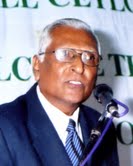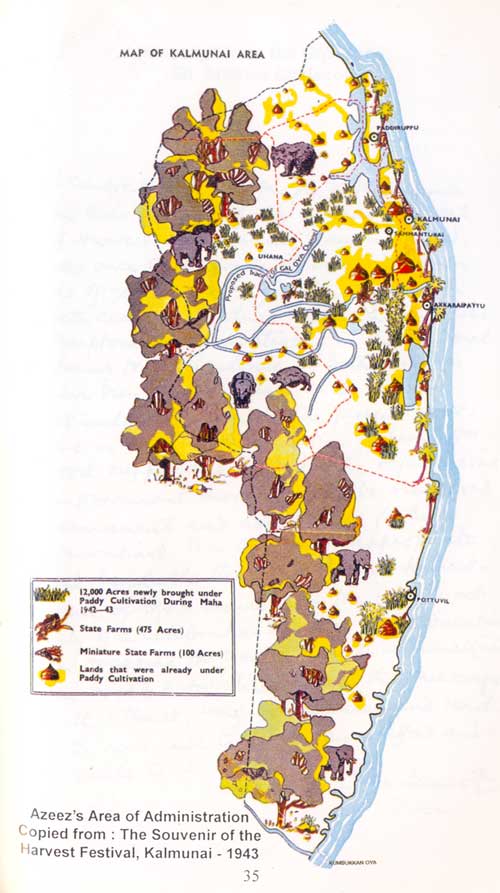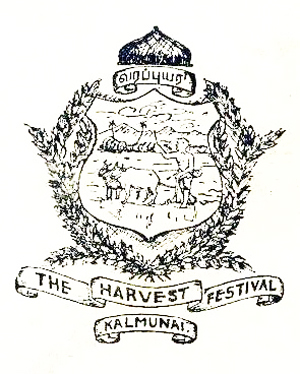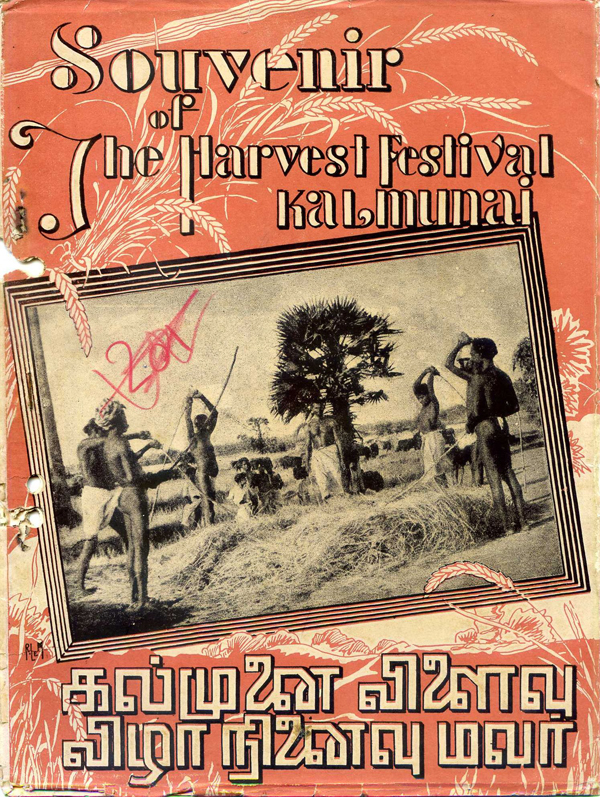 ARTICLE ON THIRTY NINTH COMMEMORATION MEETING 2012
ARTICLE ON THIRTY NINTH COMMEMORATION MEETING 2012
Dr. A.M.A. Azeez, eminent educationist, efficient administrator, erudite learned scholar in English and Tamil, brilliant orator and writer, visionary and dedicated community worker was born on 4th October, 1911 in Vannarpannai, Jaffna to a leading Muslim family. He had his childhood and entire schooling in Jaffna and received his education at the Hindu schools Vaidyeshwara Vidyalayam and Jaffna Hindu College. Azeez had stated that the influence and training he received in these institutions had stood in good stead during his life. Dr. Azeez was an iconic Nation Builder and his achievements have left lasting footprints in the sands of time.
Ceylon Civil Service
Dr. Azeez graduated with Honours in History from the University of London in 1933 and was awarded the Government Arts Scholarship. He joined the prestigious Ceylon Civil Service in 1935 being the first Muslim Civil Servant. During his administrative career from 1935 to 1948 he held many important posts and was highly commended for his services. During this period he contributed immensely and played a prominent role in agricultural development in the East during World War 2. This was his greatest achievement surpassing his successes later in forming the Ceylon Muslim Scholarship Fund, as Principal of Zahira College, Colombo and founding the All Ceylon Young Men’s Muslim Association Conference.
The Second World War was raging and all foreign supply lines of rice and other food-stuffs faced blockades, and the Japanese air raid on Easter Sunday 5th April, 1942 aggravated the situation. The Japanese armada was spotted heading towards Ceylon. The Army headquarters was alerted and immediate action was taken to clear the Colombo harbour of ships that were berthed there and to hide them. The Japanese bombarded various parts of Colombo and the suburbs lasting 20 minutes. On 7th April the aircraft bombed the Trincomalee harbour. The colonial Governor, Sir Andrew Caldecott, placed the country on a war footing. There was a shortage of food and the AGAs were made responsible for food drives. Azeez, who was attached to H.M. Customs, had to sleep the nights in the port with his driver Caldera by his side.
The Government of the day had to find ways and means of accelerating local food production. The Southern region of Batticaloa District was chosen as one of the areas to boost local food production.
The Batticaloa District at that time extended from Verugal Ganga in the North to Kumbukkan Oya in the South and the boundaries of Badulla District in the West – fairly a vast extent of area and a long terrain to manage. The area was administered by the Kachcheri situated in the Dutch Fort in the town of Batticaloa and the Government Agent in 1942 was M.K.T. Sandys, who was an Englishman. To activate and accelerate the Food Production Drive, it was necessary to open an Emergency Kachcheri in Kalmunai. Azeez who at that time was holding the responsible position of Additional Landing Surveyor of H.M. Customs was chosen to be the AGA, specially selected by Hon. D.S. Senanayake, Minister of Agriculture and transferred at very short notice with specific orders of accelerating food production.
His dedication to service was very explicit when he readily agreed to relinquish his prestigious post and comforts of Colombo in order to travel the long way to Kalmunai. Azeez left with his family and assumed duties in Kalmunai on 16th April, 1942. At the public meeting held during the Harvest Festival later in 1943, Hon. D.S. Senanayake stated his reasons for selecting Azeez, “that he felt that if they could utilize one of the Muslims in the Civil Service the people would co-operate and do their best. When Azeez came here he was able to get the co-operation of the Tamils and the Muslims, and he hoped that the co-operation would continue”. The Statesman he was, Hon. Senanayake, though he avoided saying so, would have selected Azeez realising that he is a Northern Muslim having close ties with the Tamil community.
On his maiden experience Azeez states: “The best way to understand the nature of life of the people living in a particular region is to reside amongst them. Being accustomed to only the urban style of living in Colombo, living among the cultivators of Kalmunai was a new, rich and rewarding experience. I understood their pattern of living, habits, customs, traditions and also constraints in their economic development. I began to realize the importance of farmers in the economy of this country. Earlier I was unaware of the importance of the role played by the villagers in the political, social and cultural life of the Muslim community”.
Food Production
The main objective of setting up the Emergency Kachcheri in Kalmunai was to accelerate the food production and Azeez handled this task most efficiently. His area of administration was Karavahupattu (Vanniar: M.S. Kariapper); Sammanthuraipattu (M.M. Abdul Majeed); Akkaraipattu (W.H. Kanagaratnam); Panamapattu (A. Sinnalebbe) and Wewagampattu (L.B. Madurawa). This is the entirety of the present Amparai District. The post of ‘Vanniar’ was equivalent to the present Divisional Secretary, but had wider powers and more responsibility. The Chief Irrigation Officer was M.M. Ebrahim. The area of administration extended from Paddiruppu to Kumana on the coast line.
The first meeting convened by the AGA was held at the Kalmunai Rest House on May 6, 1942. At the meeting that began at 9 a.m. and lasted till 5.30 p.m., it was resolved as follows:
· State land to be distributed for clearance and cultivation
· Grant of Rs. 20 per acre to be paid for clearance and 21/2 bushels of seed-paddy per acre
(Gold was Rs. 10/- a sovereign at that time)
· Rehabilitate abandoned village tanks and channels
· Encourage systematic paddy cultivation in already existing vast extent of fallow paddy fields
· Establishing Government-run goat farms in Malwatta, Nintavur and Thirukkovil
· Establishing poultry farms in Maruthamunai, Sainthamaruthu and Palamunai
· Assistance to the private sector to start goat and poultry farms
· Subsidies for cultivating highland crops
· Establishing a model agriculture farm
A week after this meeting, Land Kachcheries commenced, and at the first Land Kachcheri held, state lands were distributed as follows:
Pottanaveli, Irakkamam 130 Acres
Usaraveli, Irakkamam 50
Anaivilunthan, Sammanthurai 100
Mottaiyandaveli, Sammanthurai 60
Pooranpuri, Karaivahu 200
Kayattiyadi, Nintavur 100
Pallaveli, Ampara 50
690 Acres
The allocation of land in this manner exceeded 12,000 acres in one year. The Daily News of 29.3.1943 reported that 12,270 acres of land had been distributed in the district for paddy cultivation, which included 4,000 acres given to farmers of Akkaraipattu, Kolavil, Thambiluvil and Tirukovil. 1,520 acres were allocated for highland crops and 30,000 acres of hitherto uncultivated paddy fields were brought under the plough. The District was soon emerging as the granary of the East, which was accomplished with the completion of the Gal-Oya Development scheme in late 1940s and early 50s. Today the Amparai district contributes to 62% of paddy production from the Eastern province.
A model farm of 475 acres in extent was established at Chengatpadai in Nintavur to train farmers in modern methods of cultivation. Crops cultivated in this farm included paddy, sugar cane, banana, kurakkan, maize, ground nuts and a variety of vegetables. The labour force was 1,000. A separate division to introduce the methods of irrigation adopted by the Jaffna farmers also functioned here.
Harvest Festival
In order to celebrate the accelerated production in agriculture, a Harvest Festival was organized in this farm. Azeez was the Chairman and M.S. Kariapper the Secretary of the organizing committee. The Kalmunai District Harvest Festival and the Agricultural Exhibition were held from 27.3.1943 to 2.4.1943. The harvesting was at the Chengatpadai Farm and the exhibition was at Kalmunai Esplanade. The Agricultural Exhibition continued for a week and displayed agricultural and handicraft products.
The occasion was graced by the Minister of Agriculture and Lands D.S. Senanayake; Home Minister A. Mahadeva; State Councillors D.H. Kotelawela, A.R.A. Razik and A.S. Dharmaratnam; Director of Agriculture E. Rodrigo and GA Batticaloa V. Kumarasamy. D.S. Senanayake was conducted on a 4 mile procession along bumpy agricultural roads in a cart drawn by an elephant (a novel vehicle owned and used by A.S. Dharmaratnam, MSC for Batticaloa South) from Akkaraipattu to Chengatpadai Farm. It was used in the course of inspecting cultivated acres in the Akkaraipattu Division, which was followed by hundreds of gaily decorated bullock carts carrying many people. The Minister said that he would never forget the memorable drive and he had thoroughly enjoyed it.
Ceremonial scythes specially made for the occasion by expert Kandyan craftsmen were used to reap the first ears of paddy at the harvest festival. At the auspicious hour of 10.45 in the morning on 27.3.1943 the AGA Azeez handed over scythes to each of the distinguished guests. The ceremonial reaping of the first ears of paddy in the Wellankuda plot of the Chengatpadai Farm took place before a large gathering. The visitors reaped the first ears of paddy and they handed over the sheaves to Azeez. Afterwards M/s Senanayake and Mahadeva pounded paddy as the grain was collected and put into the mortars by Muslim women. D.S. Senanayake, mounted on an elephant, was taken in procession through the Farm to the reception shed nearly a mile away. A field lunch prepared from rice and other produce grown on the farm was served. This was the first ever such festival held in the Eastern Province and this event received glowing wide publicity in all the leading newspapers of the day.
“A very shining example as to how careful planning, encouraging guidance and consistent efforts could contribute to the success of accelerated growth of food production in the country is the Harvest Festival and Agricultural Exhibition taking place now at Kalmunai” was an editorial comment in the Observer of 29.3.1943.
In the afternoon the visitors were taken from the Kachcheri, the extensive premises of which were planted with yams, pulses, vegetables, chillies and onions, to the Kalmunai Show, where they were received by Vanniyar Mudaliyar M.S. Kariapper, who invited the Minister to declare it open.
The products of the Dept. of Agriculture and Dept. of Commerce & Industry were also exhibited. In the agriculture stall were livestock exhibits from the Akkaraipattu animal breeding centre and various exhibits from the Karadianaru farm school.
D.S. Senanayake in his address said that after the panic of the Japanese raid it was felt that they should look to for food in the Eastern Province, and appeal to the people of Batticaloa. He wished to draw the attention of the visitors from Colombo to the great achievement of Azeez and others. When there was a possibility of starvation he felt that they could not do better than appeal to Kalmunai.
A. Mahadeva said that he was glad to note the complete harmony between the Tamils and the Muslims, and hoped that these friendly feelings would continue.
The Governor, Sir Andrew Caldecott, in a message congratulated the cultivators of Kalmunai and thanked them for the rich harvest reaped.
The mission of Azeez in realizing the objective of the Kalmunai Emergency Kachcheri was very successful. The southern part of the Batticaloa District began the march of becoming a supplier of rice to other parts of the country. The grateful farmers named a mass of paddy lands as “Azeez Thurai Kandam” which perpetuates his memory to this day. M.M. Hussain Vidanayar (father of M.H.M. Ashraff) was in the forefront in encouraging cultivation in this ‘Azeez Thurai Kandam’ and in the distribution of land thereof. The whole hearted support given and sacrifices made by persons of such calibre to Azeez, made the region boast of being the granary of the East. This enabled the poor landless farmers to become owners of paddy lands.
Education
The Ceylon Muslim Scholarship Fund that has helped thousands of students for nearly seven decades to pursue their higher studies was inaugurated by Azeez in 1945. This Fund was in one way the culmination of a process that he started while serving as AGA at Kalmunai. Azeez was convinced that a community which suffered due to poverty and illiteracy could only be uplifted through providing educational opportunities backed by financial assistance. With this in view he formed the Kalmunai Muslim Educational Society in 1942, which subsequently evolved into the all Island Ceylon Muslim Scholarship Fund.
Comradeship
Azeez lived in Kalmunai only for a short period from 16th April, 1942 to 10th January, 1944, after which he was transferred back to Colombo as Deputy Food Controller and again within a month to Kandy as AGA. During this short period he transformed the attitude of the people towards a Government Agent to their surprise. This was an era, when the GA was looked upon as a regional king. No one dared to sit in the presence of a GA and everyone respectfully moved to the edges of the road whenever his vehicle or even the vehicle of a Vanniyah passed by. The ‘Residency’ was out of bounds to the people. Azeez was entirely a different man. He spoke very politely to every person coming to meet him; accepted and honoured the invitations for weddings and attended many funerals. Every Friday he attended mosques at different villages for his Jummah prayers.
Blooming of Life Long Friendship
There were two personalities with whom Azeez was very close and cherished their friendship. One was the poet Abdul Cader Lebbe of Kattankudy They continued to exchange their intellectual pursuits and were great friends until Azeez’s demise in 1973.
The other was the relationship with Swami Vipulananda which bloomed at Kalmunai. Azeez had met the Swami once in Jaffna in 1939. After this, he met the Swami together with the State Council Member V. Nalliah at Sinna Muhathuwaram Rest House in Akkaraipattu in 1943. Azeez used to meet the Swami at his birth place in Karaitivu or at Shivananda Vidyalaya, Batticaloa. They used to have lengthy discussions on matters of education, literature, folklore etc.
Azeez had stated in many of his later writings that the discussions with Swami Vipulananda, later in Kandy as well, made him to realize more and more the importance of education to his community. They also discussed about matters on language, including Arabic-Tamil which Azeez was thoroughly interested in having been influenced by his paternal uncle in Jaffna, Asena Lebbe Pulavar who was a Tamil scholar. The Swami had emphasized the importance of an Arabic-Tamil Dictionary and assured that he could help in compiling one. Azeez in course of time left the Civil Service to become the Principal of Colombo Zahira College succeeding Dr. T.B. Jayah in 1948. Azeez had confessed that the inauguration of the Ceylon Muslim Scholarship Fund and his decision later to accept the post of Principal of Zahira College were encouraged by the Swami.
Communal Harmony
The farewell functions accorded to Azeez for his selfless service manifest the cordial and close relationship among all communities in Eastern Sri Lanka. Functions were organized at Kalmunai, Sammanturai, Akkaraipattu, Kaluwanchikudy and Kattankudy. The main function was held at Kalmunai Rest House presided by State Councillor V. Nalliah and the farewell oration was by E. Rasiah, Attorney-at-Law and Vice-President of the Hindu-Muslim League. A separate function was organized for his wife at Methodist Girls Boarding School presided by Mrs. S.J.W. Alagiah and the oration was by Mrs. P. Kathiraveluppillai.
During the short span of two years Azeez travelled the length and breadth of the areas under the purview of the Kalmunai Emergency Kachcheri, worked long hours to put the district in the forefront as a leading producer of food. In 1949 the Prime Minister Hon. D.S. Senanayake was the Chief Guest at the Prize Day of Zahira College, Colombo. He commenced his address by stating, “During the war when there was a shortage of food, the present Principal, Mr. A.M.A. Azeez, was one of those who helped me considerably in the food drive. From that time I had developed a great affection for Mr. Azeez. He was then a member of the Ceylon Civil Service but he worked really as a citizen of the country”.
Dr. Azeez developed an in-depth everlasting affection towards the people of the Eastern region despite his short stay there. This was well manifest in his enormous affection and love shown to his students from the East like myself at Zahira College, Colombo. We cannot forget or ignore the tremendous contribution made by A.M.A. Azeez in the agricultural development of the East.
(S.H.M. Jameel hails from Sainthamaruthu and was a student of Zahira College, Colombo during the Azeez era. He graduated in Economics from the University of Peradeniya in 1964 and later obtained the Diploma in Education from the same University and M.A. from the Jaffna University. He was Principal of Zahira College, Kalmunai and Addalachenai Training College. He was the first Registrar of the Eastern University and left due to unstable situation in the area. He retired as Additional Secretary of the Ministry of Cultural and Religious Affairs)











